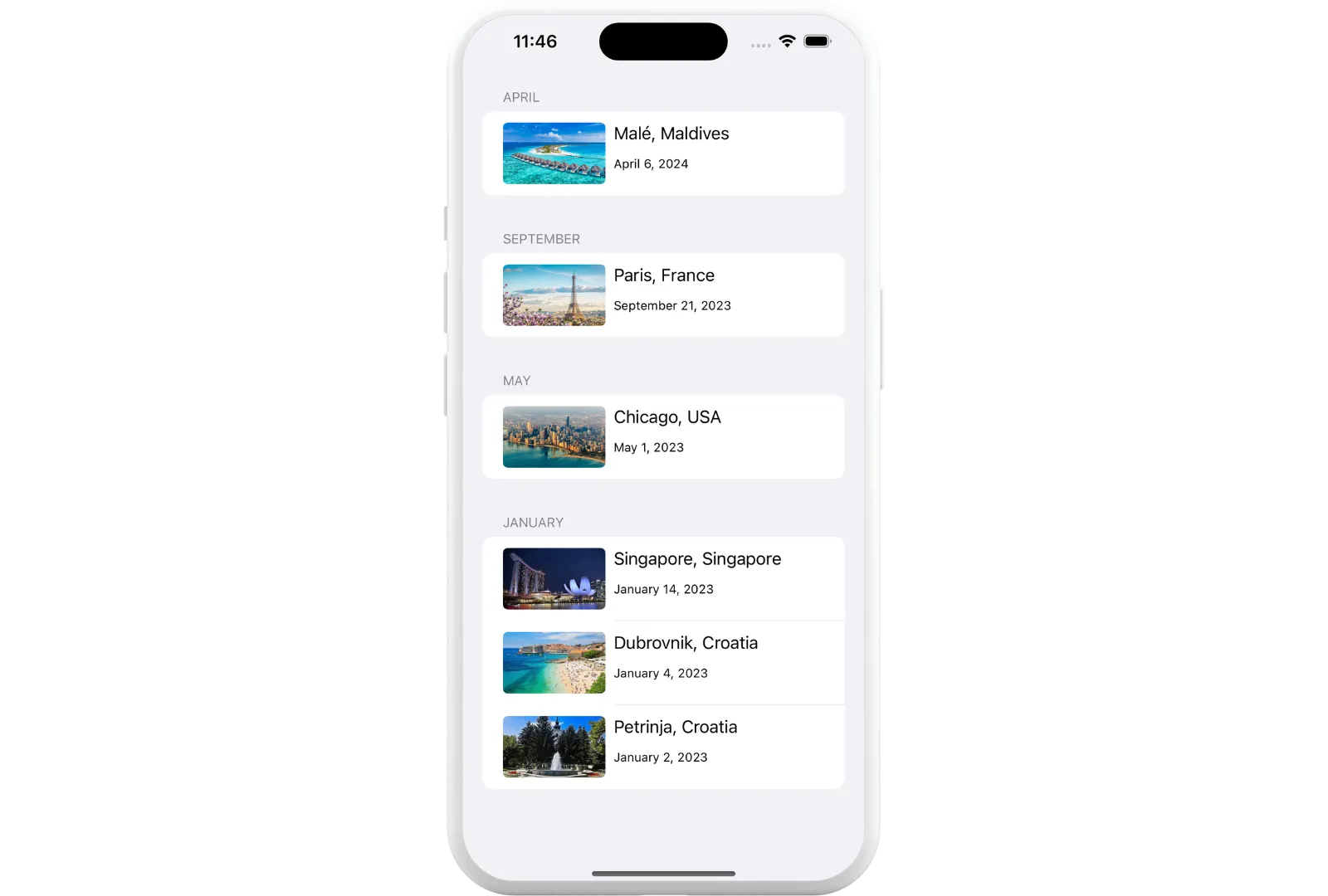Swift Algorithms is an open source package of sequence and collection algorithms. It contains many generic algorithms found in other popular programming languages.
It was created by Apple engineers to help developers improve the code we write. If you write a lot of lengthy raw loops that can often get difficult to read and understand, it’s very likely there is an algorithm in the package you can use instead.
Swift Algorithms package serves as a playground for algorithms to be tested in the real world. If they are valuable enough and used by a lot of developers, there is a chance they will be moved into the standard library.
In this post, we’ll take a look at how to implement the .chunked() algorithm to chunk an array of data and display it in your UI.
Swift Algorithms package can be added to your project via Swift Package Manager and imported with import Algorithms.
App Example
We’ll use an example app to implement the algorithm. A travel app showing a list of all the places you’ve visited or are planning to visit, sorted by date in descending order.
Data Model
We’ll use the following Travel model to display some basic information about the trip, along with the date the trip took place.
struct Travel: Identifiable, Hashable {
let id = UUID()
let country: String
let city: String
let date: Date
let image: String
}The struct conforms to Hashable so we can iterate over the elements in ForEach to display the data in the UI.
Then, we mock the data and create an array of travels.
extension Travel {
static let travels: [Travel] = [
Travel(
country: "Maldives",
city: "Malé",
date: .init(timeIntervalSince1970: 1712432922), // Apr 6, 2024
image: "male"
),
...
]
}List of travels
Now all you need is display the information in any way you’d like. In this example, I’m using a simple List that shows all my travels, including an image.
struct ContentView: View {
var body: some View {
List {
ForEach(Travel.travels, id: \.id) { travel in
HStack(alignment: .top) {
Image(travel.image)
.resizable()
.frame(width: 100, height: 60)
.scaledToFit()
.cornerRadius(5)
VStack(alignment: .leading) {
Text(travel.city + ", " + travel.country)
Text(travel.date, style: .date)
.padding(.top, 2)
.font(.caption)
}
}
}
}
}
}The app looks like this:

Chunked algorithm
Chunked algorithm has a few different variations. You can break your data into equal chunks or define a predicate, depending on the use case.
If you want to learn more about the algorithm itself, how it works and how it’s designed, check the official documentation to learn more.
It’s worth mentioning the algorithm has a complexity of O(n) where n is the number of elements in the collection. It’s very efficient!
About .chunked(by:)
While it’s great to see a list of all the travels in my app grouped together, it would be even better to split the list by month.
This is where .chunked(by:) comes into play. We can define a custom predicate to test consecutive elements in the array and it will create subsequences where the predicate is satisfied.
It’s important to mention the collection has to be sorted for chunked to work. In the case of my app, travels are already sorted by date in descending order. If your collection of data is not sorted, remember to do that first.
Using .chunked(by:)
We’ll create travelsChunked to store the new collection and chunk the travels array by comparing consecutive dates by their month.
static var travelsChunked: [[Travel]] {
let chunked = travels.chunked {
Calendar.current.isDate($0.date, equalTo: $1.date, toGranularity: .month)
}
return chunked.map { Array($0) }
}Chunked algorithm breaks the base collection into subsequences of type ArraySlice. It’s what allows the chunked to be fast and efficient. ArraySlice has the same interface as Array and generally same operations can be performed on both.
However, long-term storage of an ArraySlice is strongly discouraged. It holds a reference to the entire storage of the larger array and can cause memory leaks. We used .map() to transform it into an array instead.
Visually, it looks like this:
// Starting array
[January 2, January 4, January 14, May 1, September 21, April 6]
// After chunked is performed
[ [January 2, January 4, January 14], [May 1], [September 21], [April 6] ]Now we have an array of arrays, grouped by month and we can implement it in our UI.
UI Implementation
Switch the travels array with travelsChunked and add an additional ForEach:
struct ContentView: View {
var body: some View {
List {
ForEach(Travel.travelsChunked, id: \.self) { travels in
Section {
ForEach(travels) { travel in
HStack(alignment: .top) {
Image(travel.image)
.resizable()
.frame(width: 100, height: 60)
.scaledToFit()
.cornerRadius(5)
VStack(alignment: .leading) {
Text(travel.city + ", " + travel.country)
Text(travel.date, style: .date)
.padding(.top, 2)
.font(.caption)
}
}
}
} header: {
Text(travels.first!.date.formatted(.dateTime.month(.wide)))
}
}
}
}
}In the first ForEach you get the subsequences of the travelsChunked array and then grab the information for each travel with the second ForEach.
I’ve used Section with a header to group travels by month, but there are other UI components you can use as well. The header has a Text label that displays the month of the travel. It takes the month of the first element in the array and displays it in a wide format, which is the full month name.
The final UI looks much better:

Final Thoughts
You’ve seen how to implement one of many algorithms the Swift Algorithms package has to offer.
What’s great about implementation is how simple chunked is to use and it’s only a few lines of code. It would be more complex if you wanted to implement a custom solution. You’d also have to make sure it’s efficient and fast, especially when working with large collections of data.
Check out other algorithms in the package and see if you have any custom implementations in your code you can switch with an algorithm from the package instead.
Please feel free to reach out on Twitter if you have any questions, comments, or feedback.
Thank you for reading and happy coding!
